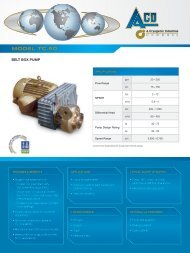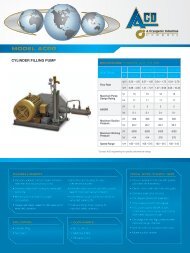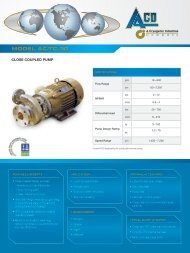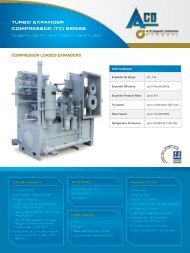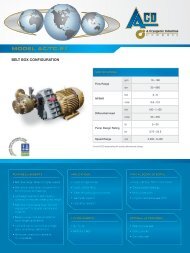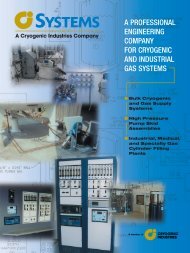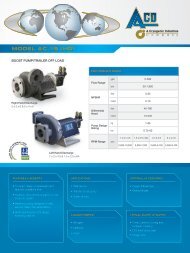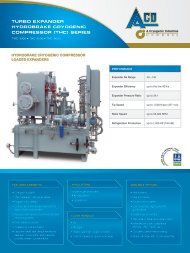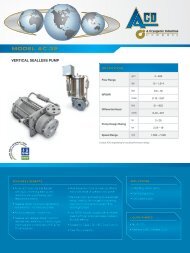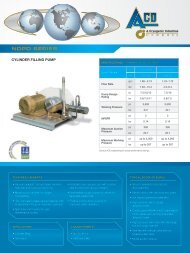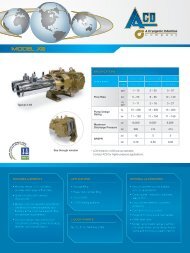Many factors need to be consideredwhen designing ambient airvaporizers. The environmentaleffect is one such criteria. When designingand specifying fan assisted and naturaldraft ambient air vaporizers, we usefour main climate zones: tropical,Mediterranean, humid continental, andmarine. Each of these zones, however,may contain micro climate zones wherethe climate may be significantly differentthan the weather around it.In discussing climatic effects, a basicunderstanding of the principles of ambientair vaporizers is necessary. Fan-assistedvaporizers utilize forced convective heattransfer where natural draft ambient airvaporizers utilize natural convectiveheat transfer. Natural convective vaporizerstypically are manufactured withthree different fin spacings, dependingon how long the vaporizers are going tobe operated before complete defrost is<strong>achieve</strong>d. Standard spaced vaporizerstypically operate less than 24 hoursbefore complete defrost and have a fintip-to-tip air gap roughly 1.5" (38 mm).(Figure 1.)Wide gap natural convection vaporizersgenerally are designed to operate threeFIGURE 1 FIGURE 2FIGURE 3 FIGURE 4to seven days without defrost and typicallyhave a fin tip-to-tip air gap spacingof 3" (75 mm) or more. (Figure 2.)Super-wide spaced ambient air vaporizersare designed to operate continuously,with the possibility ofmanual defrost required severaltimes per year. These vaporizershave a typical fin tip-to-tipspacing of 10" (254 mm) ormore. (Figure 3.) Forced convectivevaporizers are designed withmaximum heat transfer area in a minimumspace. They typically have fin tipto-tipair gap spacing of less than 1.5"(38 mm). (Figure 4.)Natural draft ambient air vaporizersoperate on the principal of natural convectiveheat transfer. Air is cooled asgravitational force pulls it past the heatexchanger fins. It therefore becomesmore dense and heavier. This densityfurther promotes a downward motiondue to gravitational effects. Forced convectiveheat transfer vaporizers rely onmechanical fan driven forced stimulationmovement of the air, therefore notrelying on gravity.The following are basic vaporizer designconsiderations dealing with the locationand duration of operation of ambient airvaporizers. Certainly other considerationsmust also be reviewed, such aselectrical /fuel requirements and availabilityof land or real estate, proximityto roads, walkways, driveways andoccupied businesses or housing.Tropical Climate ZonesFor the purpose of specifying vaporizers,tropical climate zones include equatorialregions such as Malaysia, Thailand,Indonesia, Panama, Venezuela, andBrazil. Other regions such as Japan andthe southern United States replicate thisclimate zone closely in their summermonths or monsoon season, but aregenerally closer to the humid continentalzone. Tropical climate zones are characterizedby dew point temperaturesgreater than 70 o F (21 o C). Dry bulbtemperatures generally range from 80 o F(27 o C) to 95 o F (35 o C) year round.There typically is not a wide variation inthe temperature between night and day,since the high moisture content of theatmosphere tends to trap the infraredradiation emitted by objects at night,not allowing it to escape to outer space.Both natural and fan-assisted draftambient air vaporizers should be consideredin tropical climates due to thelarge ambient air temperature drivingforce available. Flow rates under 57,000scfh (1500 Nm 3 /hr) are likely to performmore economically with natural4
convection units; flow rates over152,000 scfh (4000 Nm 3 /hr) withforced convection units. The mainadvantage of these systems is maximumvaporization capacity at minimal or nooperation cost coupled with maximumreliability.In order to maintain maximum vaporizercapacity from both types of vaporizersin this zone, the vaporizers should beswitched quite often. Typical switchingcycles would be about every four toeight hours. This is due to the highmoisture content in the atmosphere andtherefore rapid ice growth formation onthe fins which rapidly reduces the overallheat transfer coefficient. Switching lessthan every two hours to obtain evenmore vaporization capacity is bothunrealistic and dangerous. Both the naturaland forced draft vaporizers willdefrost adequately in this climate zonewithout any external energy source aslong as the off cycles are at least half theduration of the on cycles. The fan drivenunits will assist in this process.A system can be designed with a largerapproach temperature (approach temperatureis defined as the differencebetween ambient temperature and dischargegas temperature), because of theconsistently warm temperature at nightand during the day. Resulting in greatercapacity from a system rated for less inother climate zones.Mediterranean Climate ZonesMediterranean climate zoneswould include areas such asthe southern and centralcoast of California, Greece, theAlgerian Coast, and other areaslike Italy and Israel. Typically,these regions are characterizedby precipitation periods ofabout four months per year.This climate zone, like the tropicalclimate zone, is very suited to theambient air vaporizer due to the largeambient air driving force available.Generally, the same rules apply withregards to what flow natural draft andforced draft ambient air vaporizersbecome economical choices.The main difference between this climatezone as compared to the tropicalzone is the low moisture content thatcan exist six to nine months of the year.Several unique weather characteristicsresult from this. Infrared radiation mostlyescapes from the atmosphere at nightresulting in possible colder nighttime orearly morning temperatures; a considerationwhen designing approach temperaturesfor this period and ensuringminimum temperatures remain aboveminimum values. The benefit of thisdrier climate is longer switching cycles.Typically, switching less than every eighthours has little benefit, but switchingshould probably be done before 24hours to obtain maximum <strong>efficiency</strong> outof the units.Humid Continental Climate ZonesThe humid continental climate zonecovers a vast area. In the northern hemisphere,typical areas include the interiorUnited States, Southern Canada, CentralEurope, and Central Asia. These areasare characterized by somewhat tropicaldew point temperatures in the summerand extended cold, dry periods in thewinter, with a combination of the two inspring and fall.The point where forced draft ambientair vaporizers become more economicalover natural draft vaporizers is muchless apparent and must be analyzed morerigorously due to the larger variations inambient conditions. A phenomenonknown as the freeze period (the periodof time in which ambient temperaturesremain below freezing) is one key tovaporizer specifying.Typically, fan-assisted vaporizers willrequire an external energy source inorder to defrost during their off period.Electrical heater assemblies or gas firedexternal air heaters can be used. Becauseof these additional requirements, the fanambient vaporizers become less attractiveover other vaporizers.Natural draft vaporizers must be sizedsuch that each bank of on-stream andoff-stream vaporizers is capable of operatingfor one half the freeze period. Thiscould be up to several months in partsof Canada or North Central Asia, thusrequiring much more surface area(sometimes as much as four timesmore) than in other climate zones. Dueto the tropical nature that may exist inthese areas during the summer, theswitching cycles of these systems istypically based on summer conditions.Because of the potential for very lowtemperatures during winter months,special equipment additions like gassuperheaters may be required downstreamof the ambient units dependingon pipeline limitations. Lower approachtemperatures are often required duringwinter months. Fluids such as carbondioxide and propane that may be vaporizedin tropical zones by utilizing ambientunits should not be considered in humidcontinental climates since it is morelikely you will be subcooling duringwinter periods.Marine Climate ZonesMarine climate zones pose a uniquechallenge to ambient air vaporizerdesigners. Some areas included in thiszone are Britain, the northwest coast ofthe United States, British Columbia,Canada, the far northeast of the UnitedStates, Maine, Norway, New Zealand,Continued on page 75



